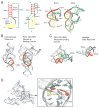Comparing the three-dimensional structures of Dicistroviridae IGR IRES RNAs with other viral RNA structures
- PMID: 18672012
- PMCID: PMC2673954
- DOI: 10.1016/j.virusres.2008.07.007
Comparing the three-dimensional structures of Dicistroviridae IGR IRES RNAs with other viral RNA structures
Abstract
The intergenic region (IGR) internal ribosome entry site (IRES) RNAs do not require any of the canonical translation initiation factors to recruit the ribosome to the viral RNA, they eliminate the need for initiator tRNA, and they begin translation from the A-site. The function of these IRESs depends on a specific three-dimensional folded RNA structure. Thus, a complete understanding of the mechanisms of action of these IRESs requires that we understand their structure in detail. Recently, the structures of both domains of the IGR IRES RNAs were solved by X-ray crystallography, providing the first glimpse into an entire IRES RNA structure. Here, I present an analysis of these structures, emphasizing how the structures explain many aspects of IGR IRES function, discussing how these structures have similarities to motifs found in other viral RNAs, and illustrating how these structures give rise to new mechanistic hypotheses.
Figures





Similar articles
-
Mechanistic role of structurally dynamic regions in Dicistroviridae IGR IRESs.J Mol Biol. 2010 Jan 8;395(1):205-17. doi: 10.1016/j.jmb.2009.10.047. Epub 2009 Oct 28. J Mol Biol. 2010. PMID: 19878683 Free PMC article.
-
Factorless ribosome assembly on the internal ribosome entry site of cricket paralysis virus.J Mol Biol. 2002 Dec 13;324(5):889-902. doi: 10.1016/s0022-2836(02)01099-9. J Mol Biol. 2002. PMID: 12470947
-
Modular domains of the Dicistroviridae intergenic internal ribosome entry site.RNA. 2010 Jun;16(6):1182-95. doi: 10.1261/rna.2044610. Epub 2010 Apr 27. RNA. 2010. PMID: 20423979 Free PMC article.
-
Functional analysis of structural motifs in dicistroviruses.Virus Res. 2009 Feb;139(2):137-47. doi: 10.1016/j.virusres.2008.06.006. Epub 2008 Jul 25. Virus Res. 2009. PMID: 18621089 Review.
-
An atypical IRES within the 5' UTR of a dicistrovirus genome.Virus Res. 2009 Feb;139(2):157-65. doi: 10.1016/j.virusres.2008.07.017. Epub 2008 Sep 11. Virus Res. 2009. PMID: 18755228 Review.
Cited by
-
A tRNA-mimic Strategy to Explore the Role of G34 of tRNAGly in Translation and Codon Frameshifting.Int J Mol Sci. 2019 Aug 11;20(16):3911. doi: 10.3390/ijms20163911. Int J Mol Sci. 2019. PMID: 31405256 Free PMC article.
-
Cis-acting RNA elements in human and animal plus-strand RNA viruses.Biochim Biophys Acta. 2009 Sep-Oct;1789(9-10):495-517. doi: 10.1016/j.bbagrm.2009.09.007. Epub 2009 Sep 23. Biochim Biophys Acta. 2009. PMID: 19781674 Free PMC article. Review.
-
A complex IRES at the 5'-UTR of a viral mRNA assembles a functional 48S complex via an uAUG intermediate.Elife. 2020 Apr 14;9:e54575. doi: 10.7554/eLife.54575. Elife. 2020. PMID: 32286223 Free PMC article.
-
Mechanistic role of structurally dynamic regions in Dicistroviridae IGR IRESs.J Mol Biol. 2010 Jan 8;395(1):205-17. doi: 10.1016/j.jmb.2009.10.047. Epub 2009 Oct 28. J Mol Biol. 2010. PMID: 19878683 Free PMC article.
-
Temperature protects insect cells from infection by cricket paralysis virus.J Virol. 2010 Feb;84(3):1652-5. doi: 10.1128/JVI.01730-09. Epub 2009 Nov 11. J Virol. 2010. PMID: 19906924 Free PMC article.
References
-
- Boehringer D, Thermann R, Ostareck-Lederer A, Lewis JD, Stark H. Structure of the hepatitis C Virus IRES bound to the human 80S ribosome: remodeling of the HCV IRES. Structure. 2005;13:1695–1706. - PubMed
-
- Broyles SS. Vaccinia virus transcription. J Gen Virol. 2003;84:2293–2303. - PubMed
-
- Cate JH, Gooding AR, Podell E, Zhou K, Golden BL, Kundrot CE, Cech TR, Doudna JA. Crystal structure of a group I ribozyme domain: principles of RNA packing. Science. 1996;273:1678–1685. - PubMed
Publication types
MeSH terms
Substances
Grants and funding
LinkOut - more resources
Full Text Sources

